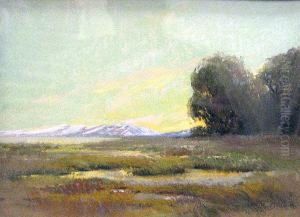Lucile Wilcox Joullin Paintings
Lucile Wilcox Joullin was an American painter and artist, known particularly for her impressionist style and her contributions to the early Californian art scene. Born Lucile Wilcox in 1867 in San Francisco, California, she was raised in a cultural environment that encouraged her artistic talents from a young age. She was the daughter of Theodore S. Wilcox, a prominent businessman, and developed an interest in art early on.
Joullin's education in art began at the California School of Design, where she was a pupil of Virgil Williams and later of Arthur Mathews and Amandus Juergensen. Her talent was evident, and she quickly gained recognition for her work. She further honed her skills by studying abroad, which was quite common for American artists at the turn of the century who sought to immerse themselves in the European art scene. Her travels took her to Paris, where she studied at the prestigious Académie Colarossi, one of the few art academies in Paris open to women at the time.
While in France, Joullin was exposed to the works of the Impressionists, and their influence is apparent in her use of light and color. She exhibited her work at the Paris Salon, a significant achievement for any artist, let alone an American woman at that time. Upon returning to California, Joullin became an active member of the San Francisco art community, contributing to its development and participating in various exhibitions, including those held by the San Francisco Art Association.
Her art typically captured the essence of the California landscape with an impressionistic touch, but she was also known for her portraiture. In 1894, she married fellow artist Ernest Joullin, and they often worked and exhibited together. Lucile's work was well-received, and she gained a reputation for her distinctive style and artistry.
Tragically, Lucile Wilcox Joullin's life was cut short when she passed away in 1921. Despite her relatively brief career, she left behind a legacy as one of California's early female artists who helped pave the way for future generations. Her works are still appreciated today and can be found in various art collections, serving as a testament to her skill and dedication to her craft.
